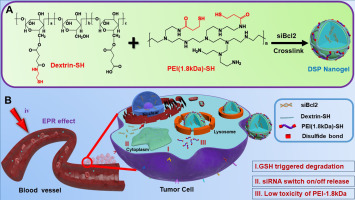Journal of Controlled Release ( IF 10.8 ) Pub Date : 2018-02-27 , DOI: 10.1016/j.jconrel.2018.02.036 Huipeng Li , Xue Yang , Fang Gao , Chenggen Qian , Chenzi Li , David Oupicky , Minjie Sun

|
In present study, gene concentrated as well as bioreduction-ruptured nanogel with local enrichment positive charge while low cytotoxicity was developed for Bcl2 siRNA delivery featured in intracellular switch on/off controlled release. Dynamic covalent bond crosslinked nanogel was formed by thiolated PEI of 1.8 kDa(PEI-1.8 kDa)and biodegradable dextrin. Once nanogel was uptake by tumor cells, high concentration of glutathione (GSH) in cytosol could bioreducible -degrade and rupture the crosslink of this dextrin nanogel (DSP) into hypotoxic PEI-1.8 kDa and dextrin, following by burst release of packed siRNA and minimizing the restriction of polymer material for siRNA transcription. This switch on/off siRNA release strategy for gene therapy exhibited equal level of the deregulation of Bcl2 protein expression determined by western blot analysis compared with cationic PEI with 25 kDa molecular weight (PEI-25 kDa) in vitro. Moreover, the gene concentrated DSP based on hypotoxic PEI-1.8 kDa and biodegradable dextrin could be administrated intravenously for systematic therapy on safely. Tumor suppression study of DSP also exhibited a superior antitumor activity in 4T1-luc tumor cell bearing BALB/C mice. Furthermore, it exhibited lower cytotoxicity, almost none hemotoxicity, moreover avoiding recognition and clearance by RES system in healthy mice. Overall, these findings suggest that this reduction-sensitive while bioreduction-ruptured polymer nanogel is an innovative strategy and holds great promise for gene and drug delivery.
中文翻译:

生物还原破裂的纳米凝胶用于乳腺癌肿瘤治疗中Bcl2 siRNA的开/关释放
在本研究中,基因浓缩以及具有局部富集正电荷的生物还原破坏的纳米凝胶,同时针对细胞内开关控制释放的Bcl2 siRNA传递开发了低细胞毒性。动态共价键交联纳米凝胶是由1.8 kDa(PEI-1.8 kDa)的硫醇化PEI和可生物降解的糊精形成的。一旦纳米凝胶被肿瘤细胞吸收,胞浆中的高浓度谷胱甘肽(GSH)可能会被生物还原-降解并破坏这种糊精纳米凝胶(DSP)的交联成为低毒性的PEI-1.8 kDa和糊精,随后爆发释放包装的siRNA,并将其最小化聚合物材料对siRNA转录的限制。体外。此外,基于次毒性PEI-1.8 kDa和可生物降解糊精的基因浓缩DSP可以安全地静脉注射进行系统治疗。DSP的肿瘤抑制研究在带有BALB / C小鼠的4T1-luc肿瘤细胞中也显示出优异的抗肿瘤活性。此外,它表现出较低的细胞毒性,几乎没有血液毒性,而且避免了RES系统在健康小鼠中的识别和清除。总体而言,这些发现表明,这种还原敏感性但生物还原破裂的聚合物纳米凝胶是一种创新策略,对基因和药物的输送具有广阔的前景。



























 京公网安备 11010802027423号
京公网安备 11010802027423号